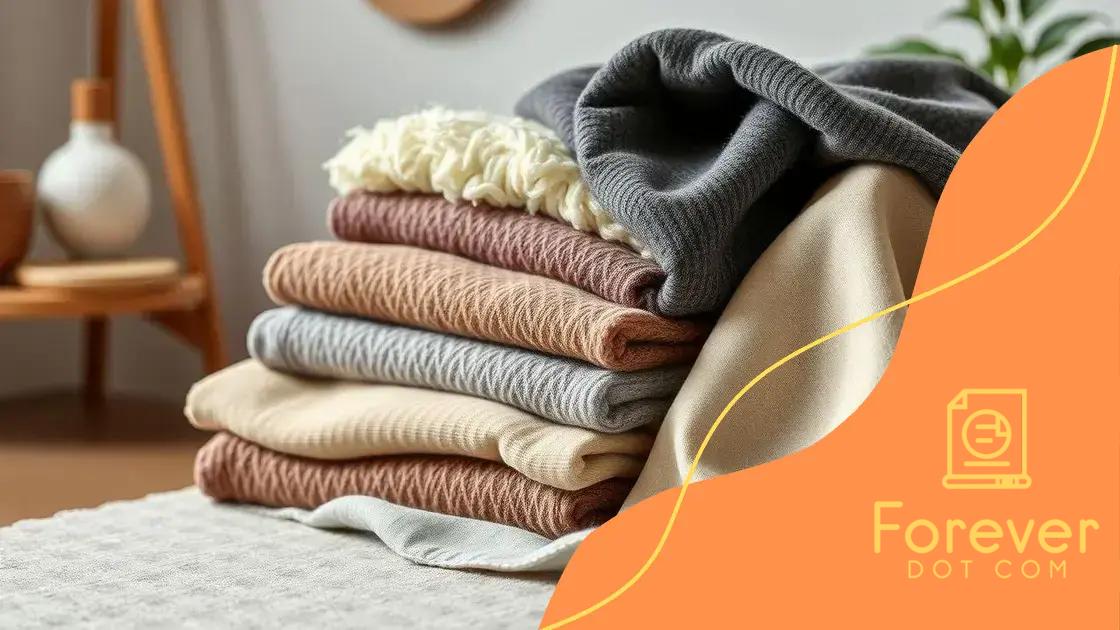How to layer clothes for transitional weather: tips and tricks

To layer clothes for transitional weather effectively, choose breathable fabrics, mix textures, and accessorize with scarves and hats for optimal warmth and style.
How to layer clothes for transitional weather can be tricky, right? With fluctuating temperatures, figuring out what to wear might feel overwhelming. But don’t worry, I’ve got some handy tips to keep you comfy and stylish!
Understanding transitional weather essentials
Understanding transitional weather essentials is crucial for staying comfortable throughout the day. Transitional weather often brings unpredictable temperatures, making it challenging to decide what to wear. Planning your outfits carefully can help you feel more at ease as you navigate the changing conditions.
Key Pieces to Include
When layering clothes for transitional weather, it’s essential to choose the right key pieces. Here are some staples you should consider:
- Lightweight jackets: A denim or bomber jacket provides warmth without being too bulky.
- Cardigans and sweaters: These can easily be added or removed as temperatures change.
- Long-sleeve tops: Perfect for comfort and versatility, they can be layered under other items.
- Scarves: A great accessory to add warmth and style, easily removed when it’s warmer.
In addition to these staples, it’s important to consider fabrics that help regulate your body temperature. Look for breathable materials like cotton or moisture-wicking fabrics that help keep you cool when it’s warm and warm when it’s cool. Layering can be an art form, and it’s important to keep it lightweight yet effective.
Colors and Patterns
Don’t forget to have fun with colors and patterns! Transitional weather is a great time to showcase your personal style. Opt for layering pieces in neutral shades, which can easily mix and match with your wardrobe. Add a pop of color or a fun pattern in your accessories – this can really brighten up your outfit.
Ultimately, understanding the basics of transitional weather essentials will help you build a versatile wardrobe. With the right pieces and a bit of creativity, you’ll be prepared for whatever the weather brings!
The art of layering: key techniques
The art of layering is all about combining different clothing items in a way that is both functional and stylish. When done correctly, layering can help you adapt to varying temperatures throughout the day while creating a fashionable look.
Understanding Layering Basics
To master layering, start with the basics. A good foundation is essential for any layered outfit. Here are some key points to consider:
- Base layer: This is your first layer, typically made from lightweight, breathable fabrics to wick moisture away from your skin.
- Middle layer: This layer adds warmth and insulation. Think sweaters or light fleeces that can easily be added or removed.
- Outer layer: Your final layer should protect against wind and rain. Look for jackets that are both stylish and functional.
Once you have your layers figured out, it’s time to think about how to mix and match different colors and textures. For instance, pairing a chunky knit sweater with a sleek, fitted shirt underneath can create visual interest. Similarly, don’t hesitate to play with patterns as well. Stripes and florals can mix in exciting ways.
Accessorizing Your Layers
Accessories are crucial to perfecting the art of layering. A few simple techniques can elevate your look. Consider adding:
- Scarves: They can add both warmth and style, helping to pull your outfit together.
- Belts: A belt can help define your waistline and give your outfit a polished look.
- Hats: A stylish hat not only keeps you warm but also adds character to your layered outfit.
Additionally, make sure your shoes complement your layered look. Ankle boots or stylish sneakers can tie everything together nicely. Mixing different elements can lead to a unique and personalized outfit that suits your taste.
Choosing the right fabrics and materials

Choosing the right fabrics and materials for your layered clothing is key to staying comfortable in transitional weather. The fabric can affect not only your look but also your comfort level throughout the day.
Types of Fabrics to Consider
Different fabrics have unique properties that can help you navigate varying temperatures. Here are some of the best options:
- Cotton: A breathable fabric that is great for base layers. It allows air to flow and keeps you comfortable.
- Wool: Ideal for insulation, it keeps you warm without overheating. Look for lightweight options for easier layering.
- Polyester: Often used in outer layers, it is good for moisture-wicking and can repel light rain.
- Silk: A luxurious choice for base layers, silk can keep you warm and is lightweight, making it easy to layer.
When choosing fabrics, consider the weight of each layer. Heavier fabrics can provide warmth, but they may make layering more cumbersome. Therefore, finding a balance between weight and warmth is essential.
Pay Attention to Texture
The texture of your clothing can also impact your layered look. Softer materials can help avoid irritation when worn close to the skin. Look for materials with a pleasant feel that won’t scratch or rub uncomfortably.
Additionally, layering different textures can add visual interest to your outfit. For example, pairing a smooth cotton shirt under a chunky knit sweater can create depth in your look.
Ultimately, understanding how to choose the right fabrics and materials will help you create versatile outfits that adapt to changing weather conditions without sacrificing style.
Accessorizing for versatile layers
Accessorizing for versatile layers is essential to enhance your layered outfits and make them uniquely yours. The right accessories can transform a simple ensemble into a stylish statement.
Essential Accessories to Consider
When it comes to layering, the following accessories can play a big role:
- Scarves: These can be used to add color and texture to your outfit. A lightweight scarf can be the perfect addition when temperatures fluctuate.
- Bags: A stylish bag can be both practical and chic, complementing your layered look while holding all your essentials.
- Jewelry: Layering necklaces can add depth to your outfit. Choose different lengths and styles for a trendy layered effect.
- Hats: A fashionable hat not only keeps you warm but also adds character to your overall look.
Additionally, consider how colors and styles can blend within your layers. For example, using a scarf that matches your outer layer can provide cohesion to your outfit while adding a pop of flair.
Playing with Textures and Patterns
Don’t shy away from combining different textures and patterns. Experimenting with various fabrics can make your outfit more dynamic. A chunky knitted scarf paired with a sleek, smooth jacket creates an engaging contrast.
When choosing accessories, think about practicality as well. For instance, a crossbody bag can be very functional and fashionable, allowing your hands to stay free while navigating your day.
Ultimately, the key to accessorizing for versatile layers is to find pieces that enhance your outfit and reflect your personal style. Think creatively and have fun with your choices!
Practical outfit examples for every occasion
Practical outfit examples for every occasion can help you navigate transitional weather with ease. By having versatile looks in your wardrobe, you can quickly adapt to different situations while staying stylish.
Casual Outfits
For a relaxed day out, consider wearing a lightweight tee paired with a long cardigan. This combination allows for easy adjustment as temperatures change. A pair of comfortable jeans or chinos completes the look. To enhance your outfit, add sneakers and a crossbody bag for practicality.
Work-Appropriate Layers
When heading to the office, layering a button-up shirt under a fitted blazer works well. Choose materials like cotton for breathability. You can pair this with tailored trousers or a knee-length skirt. Finish the outfit with loafers and a structured tote bag to keep your essentials handy.
Evening Outfits
For an evening out, a simple shift dress layered with a denim jacket can be chic and comfortable. This look transitions well from daytime activities to nighttime events. Pair it with ankle boots and statement earrings to elevate your style.
Weekend Adventures
When exploring on the weekend, go for a graphic tee layered with a lightweight puffer vest. Combine this with breathable leggings or joggers for mobility. Sports shoes are perfect for all-day comfort, and a backpack will keep your hands free for all your activities.
Having a range of outfit options prepared will allow you to dress for any occasion during transitional weather. Focus on layering efficiently with practical choices that reflect your personal style.
FAQ – Frequently Asked Questions about Layering Clothes for Transitional Weather
What are the best fabrics for layering in transitional weather?
The best fabrics for layering include cotton for breathability, wool for insulation, and polyester for moisture-wicking properties.
How can I accessorize my layered outfits effectively?
You can add scarves, hats, and layered jewelry to enhance your look while providing extra warmth and style.
What are some practical outfit examples for different occasions?
Casual outfits can include a tee with a cardigan, while work-appropriate layers might involve a button-up shirt under a blazer.
How can I create versatile looks for different weather conditions?
By mixing and matching layers, you can adapt your look easily. Have staple pieces that work well together for various occasions.






